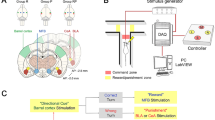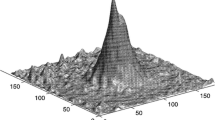Abstract
In previous studies, Periaqueductal Gray (PAG) stimulation was used to stop ratbots from moving. Due to the homology between the PAG and the intercollicular nucleus, which has been used for forward movement in birds, we investigated the possibility of PAG application to induce forward locomotion for the first time. Using a corridor maze, the traveled distances via PAG electrical stimulation were examined in nine Wistar male rats during three sessions. A custom-designed stimulator was developed to apply the stimulation. The results showed reductions in responses to stimulation over time. Accordingly, the traveled distances had negative slopes during the consecutive trials (in 8 out of the 9 rats), and the slope mean was significantly different from zero. There was a strong correlation between the stimulation parameters (electric Charge per Phase (CPP) and the Number of Pulses (NP)) and the observed slopes. The negative Movement Slopes (MS) were highly correlated with the CPP and the NP, as the Pearson's linear correlation coefficients were − 0.87 and − 0.79, respectively. The MS-CPP coefficients of determination (R-squared) were also between 0.76 and 0.95. In addition, the MS-NP coefficients of determination were between 0.63 and 0.87. Thus, it is concluded that the electrical stimulation parameters influence the behavioral outcomes directly. Furthermore, the PAG area may be considered a suitable candidate for forward locomotion control in the future if the area is harnessed effectively to prevent undesirable chaotic behaviors.







Similar content being viewed by others
Data Availability
The datasets of the current study are available from the corresponding authors upon requests. Please refer to the following Google Drive link to observe the experiment’s clips: https://drive.google.com/drive/folders/11wreChR1X1SaeZvQH-EdMY7yOGLrVcnP?usp=share_link
References
Romano, D., Donati, E., Benelli, G., & Stefanini, C. (2019). A review on animal–robot interaction: From bio-hybrid organisms to mixed societies. Biological Cybernetics, 113, 201–225. https://doi.org/10.1007/s00422-018-0787-5
Zhou, Z. Y., Liu, D. H., Sun, H., Xu, W. B., Tian, X. M., Li, X. Y., Cheng, H., & Wang, Z. L. (2021). Pigeon robot for navigation guided by remote control: System construction and functional verification. Journal of Bionic Engineering, 18, 184–196. https://doi.org/10.1007/s42235-021-0013-3
Talwar, S. K., Xu, S., Hawley, E. S., Weiss, S. A., Moxon, K. A., & Chapin, J. K. (2002). Rat navigation guided by remote control. Nature, 417(6884), 37–38. https://doi.org/10.1038/417037a
Sun, C., Zheng, N. G., Zhang, X. L., Chen, W. D., & Zheng, X. X. (2013). Automatic navigation for rat-robots with modeling of the human guidance. Journal of Bionic Engineering, 10(1), 46–56. https://doi.org/10.1016/S1672-6529(13)60198-5
Xu, K., Zhang, J. C., Zhou, H., Lee, J. C. T., & Zheng, X. X. (2016). A novel turning behavior control method for rat-robot through the stimulation of ventral posteromedial thalamic nucleus. Behavioural Brain Research, 298, 150–157. https://doi.org/10.1016/j.bbr.2015.11.002
Khajei, S., Shalchyan, V., & Daliri, M. R. (2019). Ratbot navigation using deep brain stimulation in ventral posteromedial nucleus. Bioengineered, 10(1), 250–260. https://doi.org/10.1080/21655979.2019.1631103
Yu, Y. P., Wu, Z. H., Xu, K., Gong, Y. Y., Zheng, N. G., Zheng, X. X., & Pan, G. (2016). Automatic training of rat cyborgs for navigation. Computational Intelligence and Neuroscience. https://doi.org/10.1155/2016/6459251
Yoshimoto, A., Shibata, Y., Kudara, M., Ikegaya, Y., & Matsumoto, N. (2022). Enhancement of motor cortical gamma oscillations and sniffing activity by medial forebrain bundle stimulation precedes locomotion. Eneuro. https://doi.org/10.1523/ENEURO.0521-21.2022
Yun, S. H., Koh, C. S., Jeong, J. S., Seo, J. M., Ahn, S. H., Choi, G. J., Shim, S. Y., Shin, J. W., Jung, H. H., Chang, J. W., & Kim, S. J. (2019). Remote-controlled fully implantable neural stimulator for freely moving small animal. Electronics, 8(6), 706. https://doi.org/10.3390/electronics8060706
Wang, H., Yang, J. Q., Lv, C. Z., Huai, R. T., & Li, Y. X. (2018). Intercollicular nucleus electric stimulation encoded “walk forward” commands in pigeons. Animal Biology, 68(2), 213–225. https://doi.org/10.1163/15707563-17000053
Lin, J. Y., Yu, C. N., Jia, J., Zhang, S. M., Wang, Y. W., Chen, W. D., & Zheng, X. X. (2010) Using dlPAG-evoked immobile behavior in animal-robotics navigation. 2010 5th International Conference on Computer Science & Education, IEEE, Hefei, China, pp. 1295–1298. DOI: https://doi.org/10.1109/ICCSE.2010.5593729
Chen, S. C., Zhou, H., Guo, S. C., Zhang, J. C., Qu, Y., Feng, Z. Y., Xu, K., & Zheng, X. X. (2015). Optogenetics based rat–robot control: Optical stimulation encodes “stop” and “escape” commands. Annals of Biomedical Engineering, 43, 1851–1864. https://doi.org/10.1007/s10439-014-1235-x
Chen, S. C., Qu, Y., Guo, S. C., Shi, Z. Y., Xu, K., Zheng, X. X. (2013) Encode the “STOP” command by photo-stimulation for precise control of rat-robot. 2013 35th Annual International Conference of the IEEE Engineering in Medicine and Biology Society (EMBC), IEEE. Osaka, Japan, pp. 2172–2175. DOI: https://doi.org/10.1109/EMBC.2013.6609965
Deng, H. F., Xiao, X., & Wang, Z. R. (2016). Periaqueductal gray neuronal activities underlie different aspects of defensive behaviors. Journal of Neuroscience, 36(29), 7580–7588. https://doi.org/10.1523/JNEUROSCI.4425-15.2016
Schuessler, B. (2022). Thinking outside the conditioning box: ethological paradigms for studying fear, anxiety and risky decision-making in rodents, Doctoral dissertation, University of Washington
Reis, F. M., Lee, J. Y., Maesta-Pereira, S., Schuette, P. J., Chakerian, M., Liu, J., La-Vu, M. Q., Tobias, B. C., Ikebara, J. M., Kihara, A. H., Canteras, N. S., Kao, J. C., & Adhikari, A. (2021). Dorsal periaqueductal gray ensembles represent approach and avoidance states. eLife, 10, e64934. https://doi.org/10.7554/eLife.64934
Evans, D. A., Stempel, A. V., Vale, R., & Branco, T. (2019). Cognitive control of escape behaviour. Trends in Cognitive Sciences, 23(4), 334–348. https://doi.org/10.1016/j.tics.2019.01.012
Kim, L. H., Sharma, S., Sharples, S. A., Mayr, K. A., Kwok, C. H., & Whelan, P. J. (2017). Integration of descending command systems for the generation of context-specific locomotor behaviors. Frontiers in Neuroscience, 11, 581. https://doi.org/10.3389/fnins.2017.00581
Lefler, Y., Campagner, D., & Branco, T. (2020). The role of the periaqueductal gray in escape behavior. Current Opinion in Neurobiology, 60, 115–121. https://doi.org/10.1016/j.conb.2019.11.014
Ram, A. (2021). The periaqueductal grey in opioid tolerance and chronic pain. Doctoral Dissertation, Utah State University, All graduate theses and dissertations, 8142
Godoi, M. M., Junior, H. Z., da Cunha, J. M., & Zanoveli, J. M. (2020). Mu-opioid and CB1 cannabinoid receptors of the dorsal periaqueductal gray interplay in the regulation of fear response, but not antinociception. Pharmacology Biochemistry and Behavior, 194, 172938. https://doi.org/10.1016/j.pbb.2020.172938
Khajei, S., Mirnajafi-Zadeh, J., Sheibani, V., Ahmadi-Zeidabadi, M., Masoumi-Ardakani, Y., Rajizadeh, M. A., & Esmaeilpour, K. (2021). Electromagnetic field protects against cognitive and synaptic plasticity impairment induced by electrical kindling in rats. Brain Research Bulletin, 171, 75–83. https://doi.org/10.1016/j.brainresbull.2021.03.013
(2011) Arle, J., & Shils, J. L. (Eds). Essential neuromodulation. Academic Press, Cambridge, USA. https://doi.org/10.1016/C2009-0-61346-5
Öner, M., & Deveci Kocakoç, İ. (2017). JMASM 49: a compilation of some popular goodness of fit tests for normal distribution: their algorithms and MATLAB codes (MATLAB). Journal of Modern Applied Statistical Methods, 16(2), 547. https://doi.org/10.22237/jmasm/1509496200
Wei, J., Chen, T., Liu, G. Y., & Yang, J. M. (2016). Higher-order multivariable polynomial regression to estimate human affective states. Scientific Reports, 6(1), 1–13. https://doi.org/10.1038/srep23384
Berrar, D. (2018). Cross-validation. Encyclopedia of Bioinformatics and Computational Biology. https://doi.org/10.1016/B978-0-12-809633-8.20349-X
Gupta, A., Sharma, A., & Goel, A. (2017). Review of regression analysis models. International Journal of Engineering Research and Technology, 6(08), 58–61. https://doi.org/10.17577/IJERTV6IS080060
Taylor, R. (1990). Interpretation of the correlation coefficient: A basic review. Journal of Diagnostic Medical Sonography, 6(1), 35–39. https://doi.org/10.1177/875647939000600106
Farakhor, S., Shalchyan, V., & Daliri, M. R. (2019). Adaptation effects of medial forebrain bundle micro-electrical stimulation. Bioengineered, 10(1), 78–86. https://doi.org/10.1080/21655979.2019.1599628
Job, R. S., & Dalziel, J. (2000). Defining fatigue as a condition of the organism and distinguishing it from habituation, adaptation, and boredom. In P. A. Hancock & P. A. Desmond (Eds.), Stress, workload, and fatigue (pp. 466–476). CRC Press, Boca Raton, USA: Lawrence Erlbaum Associates Publishers. https://doi.org/10.1201/b12791
Mason, P. A., & Milner, P. M. (1986). Temporal characteristics of electrical self-stimulation reward: Fatigue rather than adaptation. Physiology & Behavior, 36(5), 857–860. https://doi.org/10.1016/0031-9384(86)90443-9
McMorris, T., Barwood, M., Hale, B. J., Dicks, M., & Corbett, J. (2018). Cognitive fatigue effects on physical performance: A systematic review and meta-analysis. Physiology & Behavior, 188, 103–107. https://doi.org/10.1016/j.physbeh.2018.01.029
Van Cutsem, J., Marcora, S., De Pauw, K., Bailey, S., Meeusen, R., & Roelands, B. (2017). The effects of mental fatigue on physical performance: A systematic review. Sports Medicine, 47(8), 1569–1588. https://doi.org/10.1007/s40279-016-0672-0
Parto Dezfouli, M., & Daliri, M. R. (2015). The effect of adaptation on the tuning curves of rat auditory cortex. PLoS ONE, 10(2), e0115621. https://doi.org/10.1371/journal.pone.0115621
Peper, A. (2009). Intermittent adaptation. Pharmacopsychiatry, 42(S 01), S129–S143. https://doi.org/10.1055/s-0029-1202848
Clerke, J. A., Congiu, M., & Mameli, M. (2021). Neuronal adaptations in the lateral habenula during drug withdrawal: Preclinical evidence for addiction therapy. Neuropharmacology, 192, 108617. https://doi.org/10.1016/j.neuropharm.2021.108617
Tykocinski, M., Shepherd, R. K., & Clark, G. M. (1995). Reduction in excitability of the auditory nerve following electrical stimulation at high stimulus rates. Hearing Research, 88(1–2), 124–142. https://doi.org/10.1016/0378-5955(95)00108-G
Forbes, A., & Rice, L. H. (1929). Quantitative studies of the nerve impulse: IV Fatigue in peripheral nerve. American Journal of Physiology-Legacy Content, 90(1), 119–145. https://doi.org/10.1152/ajplegacy.1929.90.1.119
Newland, P., Starkweather, A., & Sorenson, M. (2016). Central fatigue in multiple sclerosis: A review of the literature. The Journal of Spinal Cord Medicine, 39(4), 386–399. https://doi.org/10.1080/10790268.2016.1168587
Lorist, M. M., & Tops, M. (2003). Caffeine, fatigue, and cognition. Brain and Cognition, 53(1), 82–94. https://doi.org/10.1016/S0278-2626(03)00206-9
McIntire, L. K., McKinley, R. A., Nelson, J. M., & Goodyear, C. (2017). Transcranial direct current stimulation versus caffeine as a fatigue countermeasure. Brain Stimulation, 10(6), 1070–1078. https://doi.org/10.1016/j.brs.2017.08.005
Thiel, C. M., & Fink, G. R. (2007). Visual and auditory alertness: Modality-specific and supramodal neural mechanisms and their modulation by nicotine. Journal of Neurophysiology, 97(4), 2758–2768. https://doi.org/10.1152/jn.00017.2007
Haenggeli, A., Zhang, J. S., Fischer, M. W., Pelizzone, M., & Rouiller, E. M. (1998). Electrically evoked compound action potential (ECAP) of the cochlear nerve in response to pulsatile electrical stimulation of the cochlea in the rat: Effects of stimulation at high rates. Audiology, 37(6), 353–371. https://doi.org/10.3109/00206099809072989
Cohen, E. D. (2009). Effects of high-level pulse train stimulation on retinal function. Journal of Neural Engineering, 6(3), 035005. https://doi.org/10.1088/1741-2560/6/3/035005
Kilgore, K. L., & Bhadra, N. (2004). Nerve conduction block utilising high-frequency alternating current. Medical and Biological Engineering and Computing, 42, 394–406. https://doi.org/10.1007/BF02344716
Acknowledgements
The authors would like to thank “Kerman Neuroscience Research Center” for their full support in terms of providing the financial grant and the required instruments.
Author information
Authors and Affiliations
Corresponding authors
Ethics declarations
Conflict of interest
The authors declare that no conflicting interests exist in the current work.
Additional information
Publisher's Note
Springer Nature remains neutral with regard to jurisdictional claims in published maps and institutional affiliations.
Rights and permissions
Springer Nature or its licensor (e.g. a society or other partner) holds exclusive rights to this article under a publishing agreement with the author(s) or other rightsholder(s); author self-archiving of the accepted manuscript version of this article is solely governed by the terms of such publishing agreement and applicable law.
About this article
Cite this article
Khajei, S., Khorasani, A., Afarinesh, M.R. et al. Movement Trend Alterations in the Periaqueductal Gray (PAG)-Employed Ratbot Navigation Are Correlated with Stimulation Parameters. J Bionic Eng 21, 866–876 (2024). https://doi.org/10.1007/s42235-023-00464-5
Received:
Revised:
Accepted:
Published:
Issue Date:
DOI: https://doi.org/10.1007/s42235-023-00464-5




